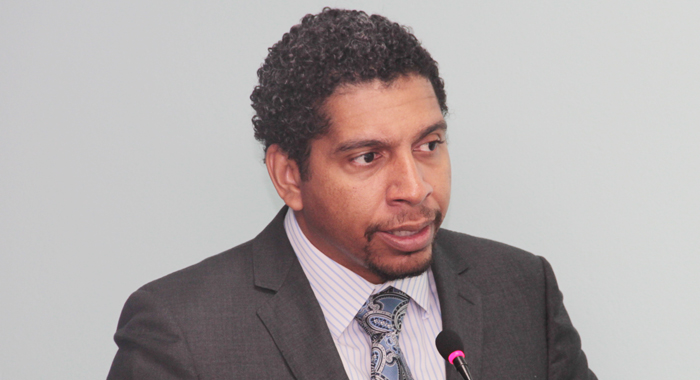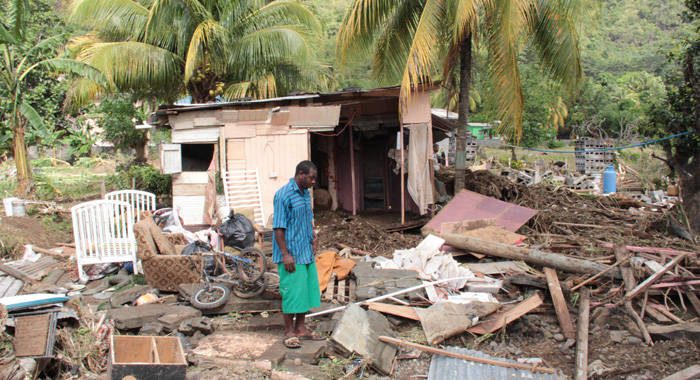As Caribbean countries prepare for the Third United Nations Conference on Small Island Developing States (SIDS) in Samoa, a warning has come from St. Vincent and the Grenadines that the region has been developing within different “straight jackets” and there is need for the developed world to view SIDS from a different perspective.
“When we go to Samoa, we don’t simply say we are vulnerable, we don’t simply go to Samoa with a tale of woe, but we say this is what you can do about it, and one of the things we have to do about it, is have the world look at us with new eyes,” Minister of Foreign Sen. Camillo Gonsalves told a regional preparatory meeting last week.
“And the eyes can’t simply be wearing the glasses of per capita GDP (gross domestic product). It has to be a more nuanced vision, and part of that nuance has to be the vulnerability of Small Island Developing States — the vulnerability premised on our size, our remoteness, our susceptibility to natural disasters, all of it. We have to talk about that. We have to resolve that in Samoa,” Gonsalves noted.
The Samoa conference will be held from September 1-4 under the theme “The Sustainable Development of Small Island States Through genuine and Durable Partnerships”.
It will seek to assess progress and remaining gaps; renew political commitment by focusing on practical and pragmatic actions for further implementation; identify new and emerging challenges and opportunities for the sustainable development of SIDS and means of addressing them; and identify priorities for the sustainable development of SIDS to be considered in the elaboration of the post-2015 UN development agenda.
Gonsalves, a former ambassador to the United Nations, said the international community pays attention to SIDS every 10 years noting that at the time of the 1994 conference in Barbados, the environmental and economic circumstances were significantly different from the present situation.
He said climate change was not the topic that it is today, the last global recession had taken place in 1930s, and the region had not examined “own vulnerabilities to the tighter and greater integration of economic systems in the developed world.
“So, we were wide-eyed and naïve, to some extent,” he said, adding that the Barbados programme of action language remains the framework on which SIDS development is discuss.
“And when we negotiate at the United Nations … when we use what is becoming an outmoded framework to discuss the developmental challenges that we face today, we do ourselves a disservice,” he said.
If the region’s purpose at the Samoa meeting is to defend what was achieved in Barbados, “we are wasting our time,” Gonsalves told the preparatory meeting here last week, adding “if that’s what we are doing, this is an exercise in dancing angels on the head of a pin and we are all drawing salaries for really nothing. We have to move this thing forward.”
Gonsalves said Caribbean SIDS, historically, are trying to develop “in an ever-changing straight jacket”, including colonialism and the Cold War.
“The straight jacket today is climate change and what is an iniquitous globalization that is affecting Small Island Developing States negatively, as we saw in the case of the global economic and financial crisis,” he said.
“And these are the straight jackets that we constantly change as we development, and we must try to address when we get to Samoa and in the lead up to Samoa.”

Gonsalves said that while most Caribbean countries are ranked as middle-income countries and using that metric alone, makes St. Vincent and the Grenadines with its one billion GDP, “richer than China”.
“And if that is the metric by which we determine economic health and access to concessionary financing, and our ability to borrow ourselves out of a crisis or to spend ourselves out of a crisis. It is clearly a flawed measure.”
This, however, is the measure by which the World Bank, the IMF determine the economic strength of Caribbean countries, Gonsalves said, adding that these international institutions do no consider the region’s vulnerabilities.
“The Caribbean small island developing states are among the most heavily indebted states in the world,” Gonsalves said, noting that debt-to-GDP in the region ranges from 20 per cent in Haiti — which received significant debt forgiveness after the 2010 earthquake, to 139 per cent in Jamaica, with St. Kitts and Nevis and Grenada at 105 and 115 per cent, respectively, even as the European Union has set itself a debt-to-GDP ratio of 65 per cent.
“If your debt-to-GDP ratio is 139 per cent and you are struck by a natural disaster, … how do you borrow yourself out of that crisis? Where do you find money immediately to build your roads, your houses, your bridges, your hospitals that have been damaged? How can you set money aside in preparation for the next climate event if you have a debt to GDP ratio of over 100 per cent or approaching 100 per cent, and your debt servicing charges are that high?” Gonsalves said.
He noted that within three hours last Christmas Eve night, a trough system left damage and loss in SVG equal to 17 per cent of GDP, while the country also suffered natural disasters in 2010, and 2011, the loss and damage from each of which was in double digits.
“The issue of how we are ranked and classified has to be rectified. Not addressed, not flagged, not considered. It has to be rectified in Samoa. That has to be one of our prime objectives going into this conference…”
The former ambassador said that at the United Nations, developed countries also complain about vulnerabilities to disaster, such as Hurricanes Katrina and Sandy in the United States.
“… the difference is this, when Hurricane Katrina hits New Orleans, which is below sea level, it affects New Orleans. Life in (other parts of the United States) goes on. When three hours of rain … affects the entire nation of St. Vincent and the Grenadines, it is not a localised event. … And when we talk about vulnerability of Small Island Developing States, that is the way in which we have to have the conversation.”
The issue of preferential trading arrangements has to be revived in Samao, Gonsalves said, but added that it is an issue that cannot be resolved at that conference.
He said research by a Maltese professor shows that SIDS’ trade dependence is three times that of the next category of countries. Further, transport and freight cost as a percentage of export is most expensive in SIDS and in terms of disaster damage as a percentage of GDP, SIDS are three times that of non-island developing states.
Gonsalves further said while climate change is a big issue affecting SIDs, Samoa should not be made into a climate change conference.
“There is a process, a flawed process, but there is a process in the United Nations to resolve climate change,” he said in reference to the United Nations Framework Convention on Climate Change (UNFCCC) and the annual Conference of Parties (COP).
“And we must not delude ourselves into thinking that we in Samoa will make greater progress than the UNFCC, than the COPs that are taking place internationally. They make very poor progress, but we are not to make any better progress in Samoa,” he said.
“We have to flag it, we have to identify it, we have to demand more, we have to talk about the fact that it is an existential threat, but Samoa cannot become a climate change conference,” Gonsalves said, emphasising that in Samoa, climate change can be linked to debt relief.






